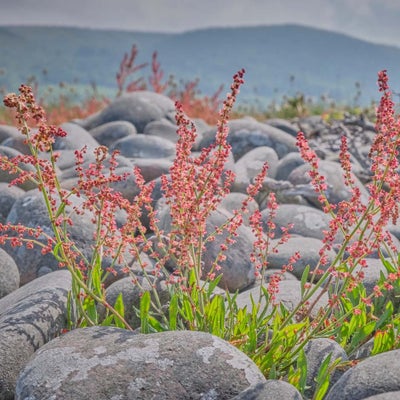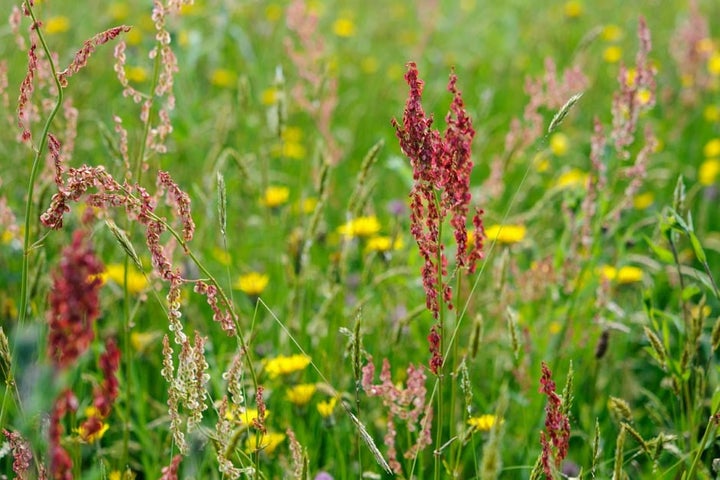
Quick facts
Rumex acetosella is the botanical name for sheep’s sorrel
It is a UK native wildflower found on heathland, grassland, roadsides and sand dunes
Over 50 species of insect feed on sheep’s sorrel, including beetles, true bugs, flies, butterflies and moths
Sheep’s sorrel can spread through borders and lawns, especially on dry, sandy, acid soil
If you need to control sheep’s sorrel, non-chemical methods are effective
What does sheep’s sorrel look like?
Sheep’s sorrel is a small, tufted that grows from a basal rosette of green, arrow-shaped leaves with distinctive pointed wings at the base. Slender, upright flower stems appear from May to August and hold loosely branched clusters of greenish to reddish flowers. These are followed by rusty brown fruits. Sheep’s sorrel grows to 30cm (1ft) tall and is distinguished from common sorrel (Rumex acetosa) by its smaller stature.

Did you know?
The bitter, lemony flavour of sorrel is traditionally used in European cooking, with leaves eaten fresh in salads or cooked in soups and sauces. The tangy taste comes from oxalic acid, which should only be eaten in small quantities, so take care not to include too many leaves in your dishes.
Is sheep’s sorrel a weed?
Sheep’s sorrel is a UK wildflower, found throughout the country on heathland, grassland, roadsides, sand dunes and shingle. It is a fantastic plant for wildlife, with the Biological Records Centre listing over 50 species of insect that use it as a food plant. These include beetles, true bugs, flies, butterflies and numerous moths. Sheep’s sorrel seeds are also eaten by ground-feeding birds such as chaffinches and thrushes.

However, as sheep’s sorrel has a quickly spreading root system and self-seeds readily, it may be considered a weed in ornamental borders and veg beds, where it could compete with other plants for space, moisture, and light.
What is a weed?
The term ‘weed’ describes a plant that is growing where it isn’t wanted. Weeds usually thrive in average garden conditions, reproducing and spreading easily. It is up to you to decide what you call a weed and what you choose to retain or remove.
Frequently asked questions about controlling sheep’s sorrel
Here are our answers to your most common questions about controlling sheep’s sorrel:
How invasive is sheep’s sorrel?
Sheep’s sorrel produces shallow, spreading roots that grow into surrounding soil and can send up new shoots along their length. It can regrow from small sections of root, so gardeners may inadvertently spread sheep’s sorrel by chopping roots up when digging or by moving soil around their gardens.
Plants also produce large amounts of seed if allowed to flower. Many will drop to the ground and germinate near the parent plant, but some may be carried further away by the wind.
The good news is that it is easy to deadhead plants to prevent them setting seed. And, while the creeping roots can be difficult to completely remove from the soil, requiring patience and persistence, prompt removal of unwanted stops plants establishing in the wrong place.
Do I need to get rid of sheep’s sorrel?
No – allowing sheep’s sorrel to grow in a species-rich lawn, wildlife corner or less-cultivated area is a great way to attract wildlife and boost the of your garden.
And, as it supports a variety of wildlife, and has attractive flowers and seedheads, sheep’s sorrel is a great addition to wildflower meadows on dry, sandy or acidic soil. It grows well alongside oxeye daisies (Leucanthemum vulgare), bird vetch (Vicia cracca), betony (Betonica officinalis) and cornflowers (Centaurea cyanus) and is commonly sold by suppliers.

It is, however, a good idea to control the spread of sheep’s sorrel to stop it becoming established or too abundant in parts of the garden where it might compete with other plants.
What is the easiest way to kill sheep’s sorrel?
If you have sheep’s sorrel growing where it is not wanted, there are several ways to remove it:
- Hoe off seedlings in early spring – hoe on a warm, dry or windy day, so exposed roots dry out quickly. minimises soil disturbance, preserving soil health.
- Fork out – use a hand fork to carefully lift the shallow, creeping roots from the soil, following each one to get as much root out as possible. As the roots are fragile and plants can regenerate from small sections, keep an eye out for regrowth and repeat as necessary. Within a lawn, re-seed any resulting bare patches.
- Prevent seeding – control the spread of sheep’s sorrel by deadheading plants you wish to keep, or by removing plants before they set seed.
- Discourage growth – if you have sheep’s sorrel growing among border plants that need feeding, try to avoid using acidifying nitrogen fertilisers such as sulphate of ammonia, as these lower soil and create the perfect conditions for sheep’s sorrel to thrive. Instead opt for poultry manure pellets as they won’t lower the pH of your soil.
- Lime to reduce acidity – this will discourage sheep's sorrel and help to limit its spread. See our page on lime and liming.
- Smother plants – cover with a layer of compostable material, such as cardboard, and then a layer about 20cm (8in) thick of organic matter, such as or wood chips. Alternatively, use a heavy grade matting. This will block light and prevent growth, causing the root system to die. Keep soil covered for a few years, topping up the mulch layer if necessary, to ensure this method is effective.
Top Tip
Don’t add sheep’s sorrel roots or seedheads to your home compost bin, as it may not reach high enough temperatures to kill them. Instead, put them in your council green waste recycling bin or take them to your local recycling site.
Should I use a weedkiller?
No – as non-chemical control methods are effective, even if time-consuming, there is no need to use weedkillers.
















